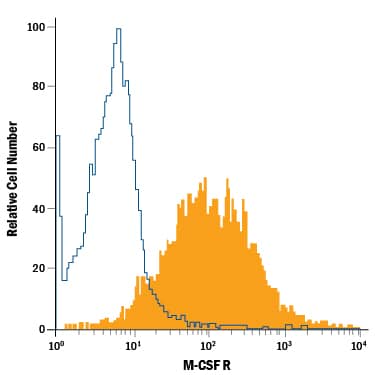Mouse M-CSF R APC-conjugated Antibody
R&D Systems, part of Bio-Techne | Catalog # FAB3818A


Key Product Details
Species Reactivity
Applications
Label
Antibody Source
Product Specifications
Immunogen
Ala20-Ser511
Accession # P09581
Specificity
Clonality
Host
Isotype
Scientific Data Images for Mouse M-CSF R APC-conjugated Antibody
Detection of M‑CSF R in J774A.1 Mouse Cell Line by Flow Cytometry.
J774A.1 mouse reticulum cell sarcoma macrophage cell line was stained with Rat Anti-Mouse M-CSF R APC-conjugated Monoclonal Antibody (Catalog # FAB3818A, filled histogram) or isotype control antibody (Catalog # IC013A, open histogram). View our protocol for Staining Membrane-associated Proteins.Applications for Mouse M-CSF R APC-conjugated Antibody
Flow Cytometry
Sample: J774A.1 mouse reticulum cell sarcoma macrophage cell line
Formulation, Preparation, and Storage
Purification
Formulation
Shipping
Stability & Storage
- 12 months from date of receipt, 2 to 8 °C as supplied.
Background: M-CSF R/CD115
M-CSF Receptor, the product of the c-fms proto-oncogene, is a member of the type III subfamily of receptor tyrosine kinases that also includes receptors for SCF and PDGF. These receptors each contain five immunoglobulin-like domains in their extracellular domain (ECD) and a split kinase domain in their intracellular region (1‑4). M-CSF receptor is expressed primarily on cells of the monocyte/macrophage lineage, dendritic cells, stem cells and in the developing placenta (1). Mouse M‑CSF receptor cDNA encodes a 977 amino acid (aa) type I membrane protein with a 19 aa signal peptide, a 492 aa extracellular region containing the ligand-binding domain, a 25 aa transmembrane domain and a 441 aa cytoplasmic domain. The mouse M-CSF R ECD shares > 99% aa identity with rat and 60-63% aa identity with corresponding sequences in human, canine, feline and bovine M-CSF R. Activators of protein kinase C induce TACE/ADAM17 cleavage of the M-CSF receptor, releasing the functional ligand-binding extracellular domain (5). M-CSF binding induces receptor homodimerization, resulting in transphosphorylation of specific cytoplasmic tyrosine residues and signal transduction (6). The intracellular domain of activated M-CSF R binds more than 150 proteins that affect cell proliferation, survival, differentiation and cytoskeletal reorganization. Among these, PI3Kinase, P42/44 ERK and c-Cbl are key transducers of M-CSF R signals (3, 4). M-CSF R engagement is continuously required for macrophage survival and regulates lineage decisions and maturation of monocytes, macrophages, osteoclasts and dendritic cells (3, 4). M-CSF R and integrin alphav beta3 share signaling pathways during osteoclastogenesis, and deletion of either causes osteopetrosis (7, 8). In the brain, microglia expressing increased M-CSF R are concentrated with Alzheimers a beta peptide, but their role in pathogenesis is unclear (9, 10).
References
- deParseval, N. et al. (1993) Nucleic Acids Res. 21:750.
- Rothwell, V.M. and L.R. Rohrschneider (1987) Oncogene Res. 1:311.
- Chitu, V. and E.R. Stanley (2006) Curr. Opin. Immunol. 18:39.
- Ross, F.P. and S.L. Teitelbaum (2005) Immunol. Rev. 208:88.
- Rovida, E. et al. (2001) J. Immunol. 166:1583.
- Yeung, Y. et al. (1998) J. Biol. Chem. 273:17128.
- Dai, X. et al. (2002) Blood 99:111.
- Faccio, R. et al. (2003) J. Clin. Invest. 111:749.
- Li, M. et al. (2004) J. Neurochem. 91:623.
- Mitrasinovic, O.M. et al. (2005) J. Neurosci. 25:4442.
Long Name
Alternate Names
Gene Symbol
UniProt
Additional M-CSF R/CD115 Products
Product Documents for Mouse M-CSF R APC-conjugated Antibody
Product Specific Notices for Mouse M-CSF R APC-conjugated Antibody
For research use only